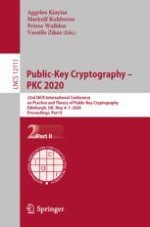2020 | OriginalPaper | Chapter
Lossy CSI-FiSh: Efficient Signature Scheme with Tight Reduction to Decisional CSIDH-512
Authors : Ali El Kaafarani, Shuichi Katsumata, Federico Pintore
Published in: Public-Key Cryptography – PKC 2020
Publisher: Springer International Publishing
Activate our intelligent search to find suitable subject content or patents.
Select sections of text to find matching patents with Artificial Intelligence. powered by
Select sections of text to find additional relevant content using AI-assisted search. powered by
